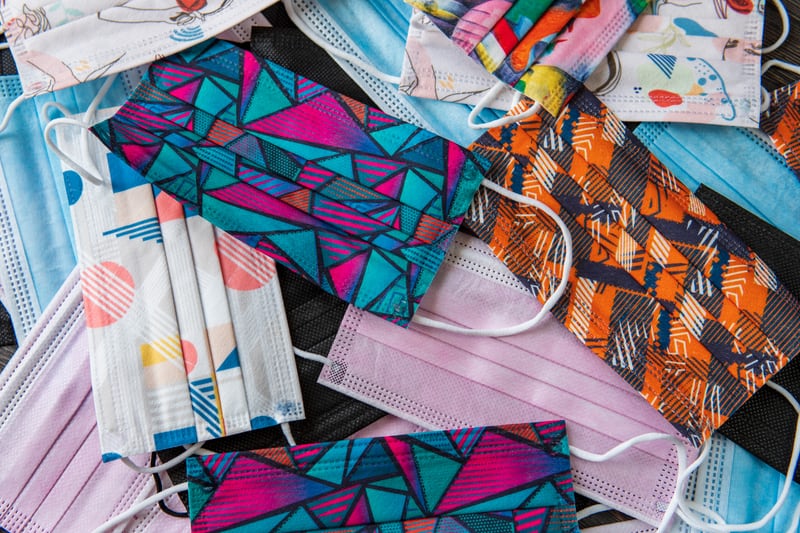The New Normal: the task of creating an adequate mask.
by Alexandria Zine
As COVID-19 reveals no indication of ceasing the CDC and healthcare workers are emphasizing that everyone gathers their armor – mask and gloves – before entering public atmospheres, such as grocery stores. The mask is a facet of the frontlines for optimal protection and the reason that there is a substantial amount of emphasis on their use. The recommendation is to utilize materials laying around in one’s home environment, but there are a few ways to gauge the effectiveness of various fabrics, as certain materials supersede others.

According to the Centers for Disease Control and Prevention (CDC), there are about five checklist qualities that are essential to the effectiveness of a mask. The mask needs to “hug” the face (shrouding the mouth, nose, and sides of the face) but not jeopardize comfort and restrict breathing. Due to the chances of difficult breathing, it is recommended that infants at the age of two or younger do not wear masks to avoid suffocation. The other qualities of a reliable mask include secure ties (around the ears or the back of the head), a multitude of layers (preferably cotton to maximize the prevention of respiratory droplets from entering), and durability in the washing machine (for the routine cleaning after a trip to the grocery store). Their website also emphasizes the incumbency for asymptomatic, symptomatic, and healthy individuals to wear a mask when leaving their home.
Before rendering a mask at home, noting the thickness of different fabrics is key to a reliable mask. According to The Washington Post, a recommendation from Wake Forest University consists of placing each potential fabric in front of a light to see the amount of light that passes through it. Within that article, Cambridge University’s research recommends that people opt for two cotton layers of a high thread count (at least 180). Friendly and readily available materials around one’s home can be T-shirts (100% cotton) and/or pillowcases.
For those who prefer to create their own mask rather than make these purchases on Etsy or other websites, the CDC suggests three ways to create a mask while in quarantine: a sewn mask, a T-shirt mask, and a bandana face covering (the third option being the least effective due to its insufficient thickness). In sewing a mask, place two rectangular pieces of cotton fabric (10” by 6”) on top of each other, with the surplus (the hem) – ¼ in. on the longer sides and ½ in. on the shorter sides– being stitched. Now, the sides of the stitched mask are the location for the 6 in. long elastic (with a thickness of ⅛ in.) for the needle or bobby pin to pull the tie through the fabric’s edge. After this threading, knot the ends and adjust the mask for a proper and comfortable fitting, preceding the final stitch.
The T-shirt mask requires fewer materials (such as a sewing machine), but requires the nobility to grab a shirt from one’s wardrobe and transform into layers of protection. The bottom section of the shirt needs to be cut (using scissors), but with a width between seven to eight inches. Out of that strip, remove six to seven inches from the folded cloth. After this removal, the fabric surrounding the missing fabric serves as the ties to secure the mask around one’s head (the neck and the back of the head).
The simplest and least effective out of these options is the bandana face covering. After laying a bandana on a flat surface, fold the cloth in half and do it again. On this folded bandana, place two hair ties on it about six inches apart and fold the excess cloth toward the middle for a final tuck. Now the hair ties assume the role of ear bands and the mask is ready for use. Another recommendation from the CDC includes sanitation before removing the mask and the avoidance of touching the mask after entering a public setting.
Many local businesses and individuals are collaborating– although separated from the boundaries of quarantine– to assemble a force of protection to flatten the curve. The Massachusetts advisory is a parallel to that issued by the CDC and like many other states, Massachusetts is emphasizing the collective utilization of masks. According to The Boston Globe, Governor Charlie Baker feels that restarting life in Massachusetts– potentially around May 18th– cannot occur until hospitalization rates plateau and people respect the social distancing guidelines. Since the ripple of cases can stray from experts’ estimations, Baker emphasizes that people value these guidelines to protect others and themselves.
Categories: Featured,